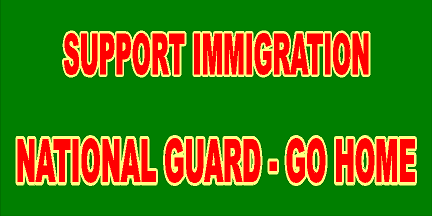LA immigration riot and anti-national guard banners are being used to show solidarity in anti immigration enforcement. In June 2025, a wave of protests erupted across the United States, with Los Angeles at the epicenter. Demonstrators rallied against federal immigration enforcement actions, leading to confrontations with law enforcement. Central to these protests were banners and signs expressing opposition to the deployment of the California National Guard. This article examines the events in Los Angeles, with comparisons to similar movements in Las Vegas, Arizona, and New York.
Los Angeles: The Epicenter of LA Immigration Riot and Anti-National Guard Banners
The protests in Los Angeles began in early June 2025, following reports of Immigration and Customs Enforcement (ICE) raids targeting immigrant communities. These operations were perceived as aggressive and disproportionately affecting undocumented individuals. The deployment of National Guard troops to assist in these operations further fueled public outrage.
Banners and Signs as Symbols of Resistance
Protesters in Los Angeles utilized banners and signs to convey their messages. Common slogans included “End ICE Raids,” “No National Guard in Our Streets,” and “Immigrants Are Welcome Here.” These visual statements served as powerful tools for expressing dissent and unifying participants.
Escalation and Clashes
The situation escalated as demonstrations intensified. On June 9, 2025, California National Guard troops were stationed outside the Edward R. Roybal Federal Building in downtown Los Angeles. Protesters gathered, holding signs and chanting slogans against the federal government’s immigration policies. The presence of the National Guard heightened tensions, leading to confrontations between demonstrators and law enforcement.
Las Vegas: Solidarity and Mobilization
A Show of Support
In Las Vegas, immigrant rights groups organized rallies to show solidarity with those affected by the immigration raids. While the scale of the protests was smaller compared to Los Angeles, the message was clear: opposition to the militarization of immigration enforcement.
Banners and Signs in Las Vegas
Participants in Las Vegas carried banners and signs similar to those in Los Angeles. Messages such as “Stop Deportations Now” and “National Guard Out of Our Communities” were prominently displayed. These visual expressions underscored the community’s stance against federal immigration policies.
Arizona: Legal Battles and Public Outcry
Legal Challenges
Arizona became a focal point for legal challenges against federal immigration policies. State officials and advocacy groups contested the legality of certain enforcement actions, arguing that they violated constitutional rights. The legal battles drew national attention to the issue.
Public Demonstrations
In response to the legal developments, public demonstrations were held across Arizona. Participants carried banners and signs demanding justice and reform. Slogans like “Justice for Immigrants” and “End Unconstitutional Raids” highlighted the public’s demand for change.
New York: East Coast Resistance
Protests in the Big Apple
New York City witnessed its own series of protests against federal immigration enforcement. Demonstrators gathered in various neighborhoods, expressing their opposition to the policies and the deployment of National Guard troops.
Banners and Signs in New York
Similar to other cities, protesters in New York used banners and signs to articulate their messages. Common phrases included “Immigrants Are Not Criminals” and “No Militarization of Immigration.” These visual statements were integral to the demonstrations, providing a clear and unified message.
Nationwide Movement and Key Takeaways
A Unified Message
Across Los Angeles, Las Vegas, Arizona, and New York, the use of banners and signs played a crucial role in the protests. They served as tools for communication, symbols of resistance, and unifying elements for participants.
The Role of the National Guard
The deployment of the National Guard in immigration enforcement operations was a central point of contention. Protesters viewed this as an overreach of federal power and a militarization of community spaces.
Legal and Political Implications
The protests highlighted significant legal and political issues, including questions about the balance of power between federal and state authorities and the rights of immigrant communities.
Conclusion
The protests in Los Angeles and other cities underscore a significant moment in the ongoing debate over immigration policy in the United States. The use of banners and signs was not just a form of expression but a powerful tool for mobilization and resistance. As the nation continues to grapple with these issues, the events of June 2025 serve as a poignant reminder of the importance of civic engagement and the enduring fight for justice and equality.
Please remember to demonstrate – protest peacefully and avoid violence. Let your voice be hear.





